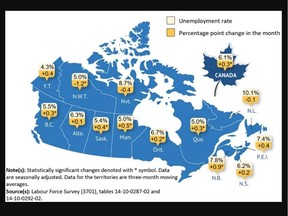N.B.’s unemployment rate climbs to highest in 27 months
It’s up nearly a percentage point from February and now two points higher than a year ago

Article content
Unemployment in New Brunswick climbed to 7.8 per cent in March, its highest level in over two years.
It’s up nearly a percentage point from February and now two points higher than a year ago.
Newly-released labour force data show that the province lost jobs month over month, although within the statistical margin of error, while New Brunswick’s expanding population and labour force again contributed to rising unemployment.
It’s part of a growing trend.
Unemployment in New Brunswick was 6.9 per cent in February, according to Statistics Canada.
It was 6.6 per cent in January, and 5.9 per cent a year ago.
Unemployment was last this high 27 months ago in January 2022.
The number of people employed in New Brunswick is still up year over year by 5,800 people, with full-time employment rising by 5,600 jobs.
But cancelling that out is a labour force that has grown by 15,000 people over the same time frame. That’s as the total population of New Brunswickers 15 years and older is up a massive 21,400 people.
Complicating that is now the emergence of slower job growth.
For the first time this year, New Brunswick recorded lower full-time employment, down 2,600 jobs, although that was partially offset by a gain of 900 part-time positions. That said, both numbers are inside Statistic Canada’s margin of error.
That’s as Canada’s unemployment rate jumped to 6.1 per cent in March, up from 5.8 per cent in February, marking the largest increase in the unemployment rate since summer 2022.
The federal agency’s labour force survey shows employment was little changed across the country, with the economy shedding 2,200 jobs, after modest increases over the last several months.
Employment decreased in Quebec by 18,000, in Saskatchewan by 6,000 jobs, and in Manitoba by 4,300 in March, while it increased in Ontario by 26,000, with little movement elsewhere.
In a note to investors on Friday, BMO chief economist Douglas Porter said the “softening” job market means “the door is open wide for the Bank of Canada to sound more dovish at next week’s policy meeting,” meaning an interest rate decrease could be on the table.
The Bank of Canada provides a next interest rate update on Wednesday.
“The number of job openings has continued to decline as labour demand softens and the unemployment rate increase has been larger than in other advanced economies in the wake of higher interest rates,” wrote RBC assistant chief economist Nathan Janzen in a note.
“Labour markets still haven’t collapsed in a way that would force the Bank of Canada to react quickly or aggressively with lower interest rates, but a rising unemployment rate and further signs that inflation pressures are broadly consistent with our base-case assumption that the central bank will shift to cuts by mid-year.”











Postmedia is committed to maintaining a lively but civil forum for discussion. Please keep comments relevant and respectful. Comments may take up to an hour to appear on the site. You will receive an email if there is a reply to your comment, an update to a thread you follow or if a user you follow comments. Visit our Community Guidelines for more information.